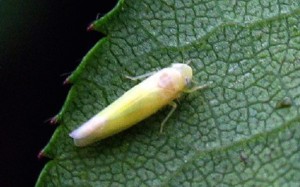
The potato leafhopper is small, but can inflict big damage on many plants.
By Tim Radford
Climate News Network
It is small, bright green and an unwelcome visitor. But global warming means that this particular agricultural menace arrives earlier than ever − and consumes more than ever.
New research has confirmed that the potato leafhopper now turns up to devour US crops on average 10 days earlier than it did 60 years ago.
Despite its informal name, Empoasca fabae is known to have developed an appetite not just for potatoes, but for anything from rhubarb to red maple trees.
It survives over the winter in the southernmost states, then moves north as the temperatures begin to rise and crops begin to sprout.
It has been observed to reproduce itself on around 200 plant species, and it also has a taste for apples, celery, beans, grapes, hops and the important perennial forage crop alfalfa, sometimes also known as lucerne.
Severe infestation
Three biologists from two U.S. universities report in PLOS One, the Public Library of Science journal, that leafhopper infestation is more severe in the warmest years, and that the damage caused by the tiny insect is likely to increase as average temperatures continue to rise.
It arrives in the growing season and pierces the plant leaf tissue to get at the sap. Its saliva carries a toxin that can cause the leaf to dry, curl and rot, and the consequent damage is called “hopperburn”.
“You don’t realise they’re even there until you see the damage to the plants . . . By then it’s too late”
“Earlier arrival dates make it particularly important for farmers to get out early in the season and scout for leafhoppers,” says William Lamp, associate professor of entomology at the University of Maryland, and one of the three authors of the study.
“They’re tiny, flighty and very hard to see. You don’t realize they’re even there until you see the damage to the plants, which can take up to a week to manifest. By then it’s too late.”
The researchers combed the records between 1951 and 2012 to track the dates in which the pest was recorded in each of 19 affected US states, and matched this with weather records over the same timespan. Such a finding was possible only because scientists had access to systematic data.
Dilip Venugopal, an ecologist, and colleague of Lamp at the University of Maryland, says: “The historical records on agricultural pests are a gold mine, made possible by decades of hard work by agricultural research and extension personnel who collect this data. There has been a decline in data collection activity over the past decade, and we would love to see an effort to ramp this up again.”
Global average temperatures have risen by 0.74 degree Celsius [1.33 degrees Fahrenheit] since 1951, and the last decade has been the warmest since climate records began.
Changed behavior
The leafhopper is only one of many long-distance migratory pests likely to change behavior in response to climate change. Other researchers have already observed crop pests’ steady movement towards higher latitudes in recent decades.
“Climate change is not just costly because temperatures and oceans rise, but because it makes it harder to feed ourselves,” says report co-author Mitchell Baker, assistant professor of biology at Queens College, City University of New York.
“Increased pest pressure in agriculture is one of the complex effects of continued warming. Predicting arrival time and severity is critical to managing this pest and others like it.”
+++++
The U.K.-based Climate News Network is run by four volunteers, all veteran journalists who have covered climate change for many years for leading British newspapers and broadcasters and are now freelancing.
